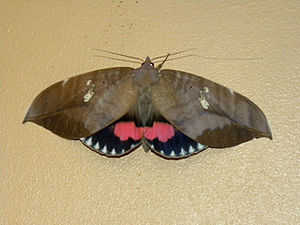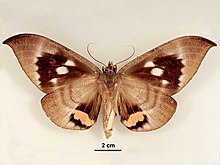Phyllodes imperialis
| Phyllodes imperialis | ||||||||||||
|---|---|---|---|---|---|---|---|---|---|---|---|---|

Phyllodes imperialis |
||||||||||||
| Systematics | ||||||||||||
|
||||||||||||
| Scientific name | ||||||||||||
| Phyllodes imperialis | ||||||||||||
| Druce , 1888 |
Phyllodes imperialis is a butterfly ( moth ) from the family of owl butterflies (Noctuidae) that occursin Australia and the South Pacific region.
features
butterfly
With an average wingspan of 130 to 140 millimeters (maximum 170 mm), the moths are among the very large owl butterflies. The forewings are leaf-shaped, gray-brown in color and show an elongated, bright discal spot , which is sometimes spiral-shaped or divided. The apex is slightly curved and very pointed. On the upper side of the hind wing, which is colored black-brown, a large red spot starting from the anal angle and many white dots along the edge stand out . The red markings of spots shine through to the underside in a weakened form. The undersides of the forewings are colored light brown in the postdiscal and submarginal regions , dark brown in the basal and disk regions and provided with three large white spots.
Caterpillar
Younger caterpillars are slender, mostly brown and sometimes green and weakly drawn. Adult caterpillars are dark to red-brown, have a strong thickening of the segments behind the head, which also show two large eye spots and two white rows of teeth similar to rows. The eye spots are outlined in dark blue and thin yellow. In the event of danger, the caterpillars curve the front part upwards, inflate it further and thus take on a dangerous and deterrent appearance for potential predators.
Distribution, habitat and subspecies
Phyllodes imperialis occurs in eastern Australia , in Papua New Guinea (including the Bismarck Archipelago ) as well as in New Caledonia , Vanuatu and the Solomon Islands . The species primarily colonizes subtropical rainforests up to an altitude of 600 meters.
The following subspecies are distinguished:
- Phyllodes imperialis imperialis from the Solomon Islands
- Phyllodes imperialis dealbata from New Caledonia and Vanuatu
- Phyllodes imperialis meyricki from northeast Australia and Papua New Guinea
- Phyllodes imperialis smithersi from southeast Queensland and northeast New South Wales
Way of life
The moths can be found in October or between December and March. When at rest with closed wings they look like a withered leaf and are barely visible to enemies. They like to suckle overripe fruits for food intake. The caterpillars feed on the leaves of Carronia multisepala or Pycnarrhena australiana , which belong to the moon seed family (Menispermaceae). Detailed information on the way of life of the species is currently not available.
Danger
In Australia the species is classified as endangered (endangered). The threat is mainly from habitat loss from, for example, deforestation, agriculture and road construction.
Individual evidence
- ↑ Video of the caterpillar
- ^ Donald PA Sands: Review of Australian Phyllodes imperialis Druce (Lepidoptera: Erebidae) with description of a new subspecies from subtropical Australia , Australian Entomologist, 39 (4), 2012, pp. 281-292
literature
Druce H .: Descriptions of new species of Lepidoptera. Annals and Magazine of Natural History No. 6, 1888, pp. 234-242
Web links
- caterpillar-eyespots - information on species
- pink-underwing-moth - Pink Underwing Moth
